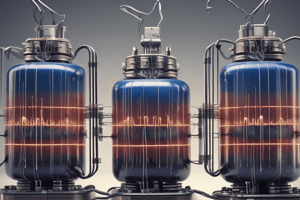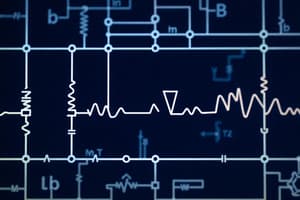Podcast
Questions and Answers
What does Kirchhoff's Voltage Law state?
What does Kirchhoff's Voltage Law state?
The algebraic sum of voltages around any closed loop is zero.
How can you calculate the total resistance in a parallel circuit?
How can you calculate the total resistance in a parallel circuit?
Add up the reciprocal of each resistor and then take the reciprocal of the sum.
What formula represents Ohm's Law and how is it used in circuits?
What formula represents Ohm's Law and how is it used in circuits?
$V=IR$ represents Ohm's Law. It is used to determine the relationship among voltage, current, and resistance.
What is current division in circuits?
What is current division in circuits?
Why are parallel circuits important in real-world applications?
Why are parallel circuits important in real-world applications?
How can Kirchhoff's rules and Ohm's Law help in calculating current in a circuit?
How can Kirchhoff's rules and Ohm's Law help in calculating current in a circuit?
What is the basic structure of a parallel circuit?
What is the basic structure of a parallel circuit?
How are components connected in a parallel circuit?
How are components connected in a parallel circuit?
What is Kirchhoff's Current Law?
What is Kirchhoff's Current Law?
How is voltage distributed in a parallel circuit?
How is voltage distributed in a parallel circuit?
Describe the flow of current in a parallel circuit.
Describe the flow of current in a parallel circuit.
How does the number of branches affect the total resistance in a parallel circuit?
How does the number of branches affect the total resistance in a parallel circuit?
Flashcards are hidden until you start studying
Study Notes
Parallel Circuits: Understanding Components, Calculations, Resistance, Current, Voltage
In many electrical systems, we encounter parallel connections of various components — wires, resistors, capacitors, or other devices — working together yet maintaining their own individual properties. To delve into this essential aspect of electricity known as parallel circuits, let's explore each important facet one by one.
Component Basics
A parallel circuit consists of multiple branches with every branch containing one component or more components connected from end to end. In most cases, these components share a common potential difference (voltage) across them due to being connected between two points of equal electric potential. For instance, consider four identical light bulbs hooked up in series with the ends touching the terminals of a single battery: here comes our first example of a parallel setup!
 Fig. 1: A simple representation of a parallel circuit.
Fig. 1: A simple representation of a parallel circuit.
Kirchhoff's Rules
To understand how current flows through parallel circuits, we utilize two fundamental laws coined by Gustav Kirchhoff:
- Kirchhoff’s Current Law: The total sum of current flowing into any closed loop is equal to the sum of current flowing out of it. This means that all the electrons entering a junction must also exit the same junction.
- Kirchhoff’s Voltage Law: The algebraic sum of voltages around any closed loop is zero. This implies that when you start your journey along a path, the net voltage change will always return back to its initial state after completing the loop.
These principles help us connect the dots between components within parallel circuits.
Ohm's Law & Calculating Total Resistance
When dealing with conductive elements such as resistors, Ohm's law plays a vital role in determining the relationship among voltage, current, and resistance: (V=IR). In parallel circuits, where numerous paths exist for current flow, calculating the overall resistance requires manipulating Ohm's law itself.
According to Ohm's law, if we have several parallel branches made of resistances (R_1), (R_2), ..., (R_N), the total inverse value ((1/\text{Resistance})) gets added up to obtain (\frac{1}{R_\text{total}}=\frac{1}{R_1}+\frac{1}{R_2}+...+\frac{1}{R_N}). In simpler terms, divide the reciprocal of each resistor by the number of resistors to find the reciprocal of the total resistance. Finally, take the reciprocal once again to determine the total resistance.
Mathematically speaking, [ R_{\rm total} = \left(\dfrac{1}{R_{1}}\ +\ \cdots\ +\ \dfrac{1}{R_{N}}\right)^{-1}. ]
Current Division
Current division occurs when there are multiple paths available for current flow. Using Ohm's law and Kirchhoff's rules, we can calculate the amount of current passing through each resistor. By doing so, we get individual fractions denoting portions of the original current flowing towards each resistor. These fractions do not necessarily equate to percentages; rather they represent ratios derived mathematically based on specific values assigned to each element.
Applications
The concept of parallel circuits extends far beyond basic examples like the ones mentioned earlier. In real applications ranging from household wiring to industrial power distribution networks, parallel circuits play a pivotal role in enhancing steady state performance, fault tolerance, and reliability by introducing redundancy to overcome failures in a system. In electronics, parallel circuits cater to features such as power supply stabilization, LED lighting configurations, and efficient data transmission in communication systems.
By understanding parallel circuits deeply, students of engineering and enthusiasts alike gain valuable insights into the practical aspects of circuits and their diverse roles in modern society.
Studying That Suits You
Use AI to generate personalized quizzes and flashcards to suit your learning preferences.




